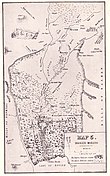Al-Mansura, Safad
| Al-Mansura | |
|---|---|

Al-Mansura (Mansoura) marked on John MacGregor's map. January 1869.
|
|
| Arabic | المنصوره |
| Name meaning | Mansûr’s place |
| Subdistrict | Safad |
| Coordinates | 33°12′59″N 35°38′26″E / 33.21639°N 35.64056°ECoordinates: 33°12′59″N 35°38′26″E / 33.21639°N 35.64056°E |
| Palestine grid | 210/291 |
| Population | 360 (1945) |
| Date of depopulation | May 25, 1948 |
| Cause(s) of depopulation | Whispering campaign |
| Current localities | She'ar Yashuv |
Al-Mansura (Arabic: المنصوره) was a Palestinian Arab village in the Safad Subdistrict. It was located 31 kilometres (19 mi) northeast of Safad on the Banyas River, to the south of what is now Dafna.
The Christian missionary W.M. Thomson, traveling during the Ottoman Empire period, in 1852, mentions a corn mill at Mansura and comments that the wider region depended on the area around Mansura for Indian corn, rice and sesamum. He saw hundreds of bee hives in Mansura. They were made from cylindrical baskets covered in mud and dung which were piled into a pyramid and covered with a thatched roof. As well as honey production the residents also exported buffalo butter from their large herds of water buffalo. He comments that the area had a large permanent population, the Ghawaraneh tribe, living in tents. He writes that he knows the names of over thirty permanent Arab encampments in the Huleh plain.
In January 1869 canoeing pioneer John MacGregor spent the night beside the village corn-mill. It was the only stone building in the area and had a flat roof. Other buildings he saw had mud walls with a reed roof or were completely made of reeds. There were also bedouin in tents. The miller was Christian and had arrived the year before following the killing of four of his children during the massacres further north. Besides milling corn he also sold gunpowder. As the MacGregor party, with his canoe on the back of a mule, approached Al-Mansura they met a procession celebrating the end of Ramadan, Eid al-Fitr. They were greeted with excitement because it was assumed they were entertainers travelling to the village to join in the celebrations. MacGregor commented that most of the men had tattoos or scars on their faces as well as ear and nose rings. The women's face were stained with blue patterns. "Their dress was the most various possible, long and short, coloured and plain, scanty and ample, of camel´s hair from Damascus, silk from Lebanon and Manchester cotton."
...
Wikipedia

